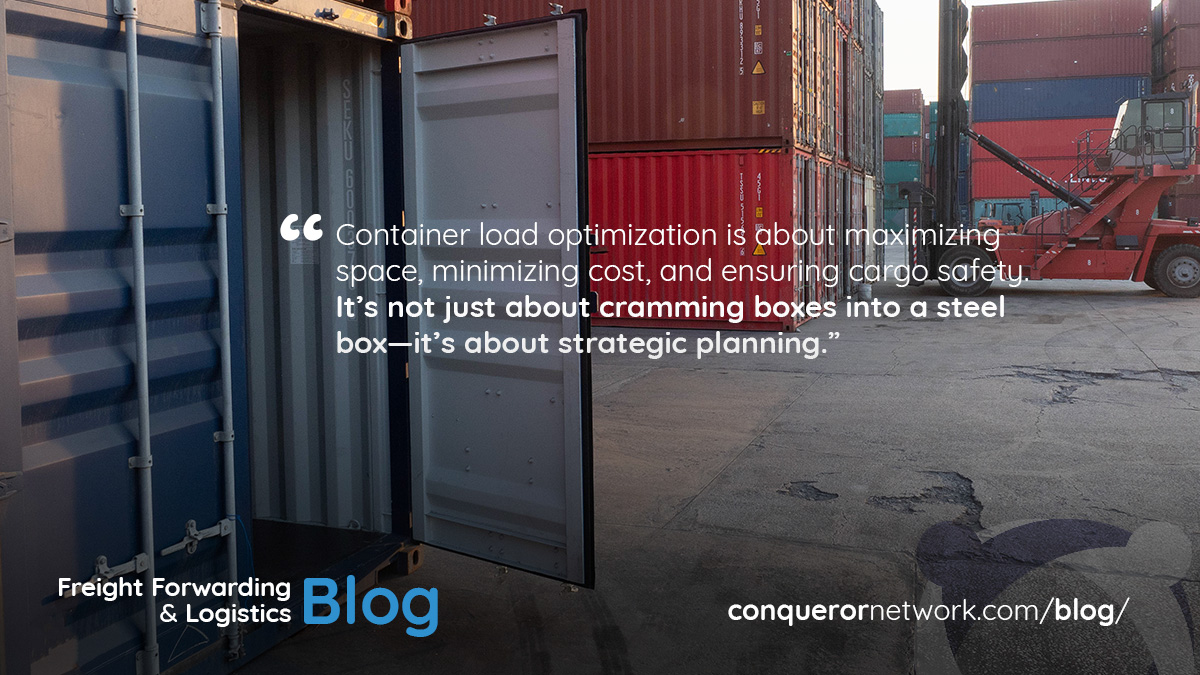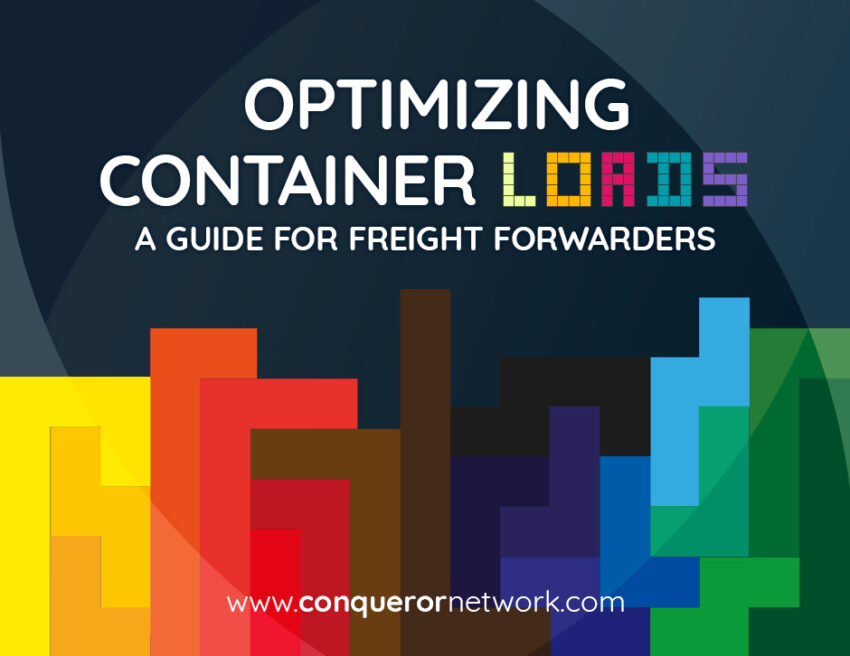Are your containers always filled to capacity, or are you paying to ship air? Have you ever calculated how much profit leaks away due to inefficient container space utilization? What if small improvements in container loading could translate into big cost savings and happier clients?
In the highly competitive world of freight forwarding, container logistics is both an art and a science. With global trade flows increasing in complexity and clients demanding greater efficiency and visibility, optimizing container loads has never been more crucial. Whether you’re moving bulk cargo across continents or managing a flurry of LCL shipments, how you load your containers could determine your operational success—or failure.

This guide dives into the best practices, strategies, and tech tools that freight forwarders can use to optimize container loads. Let’s get into the nitty-gritty of container logistics and uncover how to ship smarter, faster, and leaner.
Why Container Load Optimization Matters More Than Ever
Container load optimization is about maximizing space, minimizing cost, and ensuring cargo safety. It’s not just about cramming boxes into a steel box—it’s about strategic planning. With container rates fluctuating due to global events like the Suez Canal blockage or port congestion in Los Angeles, ensuring that every cubic meter counts can make a measurable difference in your bottom line.
For forwarders handling FCL (Full Container Load), poor planning means wasted space. For LCL (Less than Container Load), inefficient consolidation means unhappy clients. And in both cases, suboptimal container usage leads to higher freight costs, increased carbon emissions, and avoidable delays.
Understand Container Types and Capabilities
Before you can optimize a load, you need to fully understand the types of containers available and how they’re best used. Standard containers (20ft, 40ft, and High Cube) are just the beginning.
-
Reefer containers are perfect for perishables but require power sources and careful placement.
-
Flat racks and open tops are ideal for oversized or awkwardly shaped cargo.
-
Tank containers are necessary for transporting liquid bulk.
Knowing which container suits your cargo isn’t just a compliance issue—it’s a crucial part of efficient container logistics. Forwarders must also consider door sizes, floor capacity, and internal dimensions when planning a load.
Plan Ahead with Load Configuration Tools
Gone are the days when freight forwarders had to rely on paper and pen to sketch out a container layout. Today, there’s an entire ecosystem of load planning software that helps simulate container stuffing in 3D.
Tools like CargoWiz, CubeMaster, and EasyCargo let forwarders input package sizes, weights, and stacking instructions. The software then calculates the best configuration for safety, space optimization, and load distribution.
Not only do these tools help save time, but they also reduce the risk of damaged goods and allow you to provide your clients with visual proof of efficient planning.
Embrace Palletization Strategies That Work
Palletization plays a massive role in space utilization. While some clients may ship loose cartons to save on packaging, the resulting disorder in the container can actually lead to worse outcomes—more voids, shifting cargo, and potential damage.
Smart freight forwarders understand the value of:
-
Standardized pallet sizes to maximize floor coverage.
-
Stacking compatibility to avoid overhang or wasted vertical space.
-
Shrink-wrapping and labeling to speed up handling and customs clearance.
Using uniform pallets across multiple clients also makes LCL consolidation far easier and more predictable—an often overlooked advantage in container logistics.
Prioritize Weight Distribution for Safety and Compliance
Even a perfectly packed container can fail if weight isn’t properly distributed. Improper loading isn’t just inefficient—it can be dangerous. Containers with uneven loads are prone to tipping during transit and can result in penalties if they violate road weight limits or the Verified Gross Mass (VGM) requirement under SOLAS regulations.
As a forwarder, always aim to:
-
Distribute weight evenly along the container’s floor.
-
Avoid placing heavy cargo near the container doors.
-
Ensure compliance with country-specific axle load limits.
Optimizing load distribution is a key responsibility in container logistics—and one that protects your clients, your carriers, and your reputation.
Reduce Empty Space with Creative Packing Solutions
Void space is the enemy of container optimization. But even when cargo items vary in shape and size, there are ways to fill the gaps:
-
Use dunnage materials such as airbags, foam, or recycled cardboard to stabilize loads.
-
Mix cargo types (when allowed) to fill vertical and horizontal voids.
-
Introduce modular packaging that can be reconfigured depending on the shipment.
Freight forwarders who help clients re-evaluate their packaging for better load efficiency are not only solving problems—they’re adding value and building trust.
Coordinate Better with Warehouses and Carriers
Optimization doesn’t end with packing. It begins with communication. Freight forwarders need to ensure that container stuffing plans are clearly communicated to warehouses, loading teams, and last-mile partners.
-
Provide clear diagrams or digital container maps.
-
Set strict loading instructions for mixed cargo.
-
Confirm carrier/container arrival times to avoid storage delays or demurrage.
The best container logistics operations function like well-oiled machines—every stakeholder knows the plan and plays their part.
Consider Environmental and Cost Benefits
Better container loading doesn’t just save space—it reduces emissions. Fewer containers mean fewer vessel slots, fewer truckloads, and ultimately a lighter environmental footprint. In a time where shippers and consumers alike demand greener logistics, load optimization is a sustainability strategy in disguise.
Not to mention, optimized containers mean:
-
Lower per-unit shipping costs.
-
Fewer damages (less repacking or reorders).
-
Happier clients—and more repeat business.
Optimize LCL Consolidation with Smart Networking
If your business involves frequent LCL shipments, mastering container consolidation is essential. Grouping shipments from multiple clients into one container requires careful planning and strong relationships.
Many forwarders partner with trusted logistics networks to gain access to reliable agents around the world. Networks like Conqueror Freight Network or Globalia Logistics Network provide tools for better coordination and trust-based co-loading arrangements.
Better container logistics starts with better collaboration.
Final Thoughts: Make Container Optimization a Competitive Advantage
Container load optimization isn’t just a cost-cutting technique—it’s a competitive edge. In a saturated market, clients are drawn to forwarders who think one step ahead, deliver reliably, and minimize surprises.
By mastering container types, planning software, palletization, weight distribution, and collaboration, freight forwarders can unlock the full potential of container logistics.
So ask yourself again: are you shipping cargo—or air? The difference could be the margin that takes your business to the next level.


